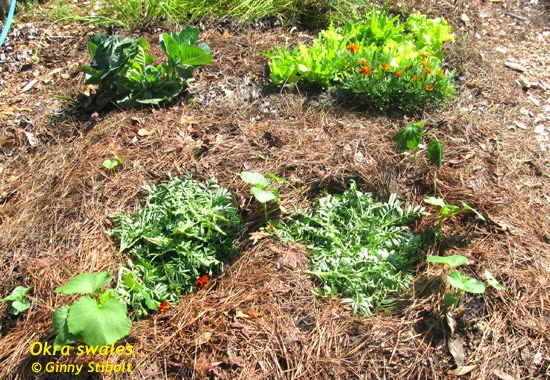I traveled over to Gainesville on May Day to meet with my editor at University Press of Florida and Marjorie Shropshire who will be illustrating my third book, "The Art of Maintaining a Native Landscape." It was a productive meeting and good progress is being made on the book--it's currently out for review. We discussed likely photos for the book and looked at Marjorie's drawings so far. (Marjorie also did the illustrations for "
Organic Methods for Vegetable Gardening in Florida.")
Marjorie and I had more work to do on the drawings, so the plan was that she would come back to my house and spend the night before she headed back to south Florida. On the way back to my house we stopped to talk to David Chiappini in Putnam County, but were interrupted by this gorgeous wildflower meadow.
 |
| Wow what a great-looking roadside wildflower field. |
 |
| Barbed wire study... |
A Florida native plant hero
We had a great time talking with David Chiappini, a native plant wholesaler. He has done so much to advance the Florida native plant availability. In addition to supplying native plant nurseries with authentic Florida stock, he also co-wrote (with Gil Nelson), and arranged the funding for "Florida's Best Native Landscape Plants: 200 Readily Available Species for Homeowners and Professionals."
This important book includes multiple photos and detailed drawings of each plant and it also provides details on size, where to plant, type of soil, and what to plant with each of the 200 plants. If you are interested in being successful with natives in Florida, this book should be on your bookshelf. David said he is happy to talk to people when they bring his book for reference, especially when it has obviously been well-used with notes, bookmarks, and dog-eared pages.
When I first met David at the Morningside native plant sale last month, he said that he had ideas he'd like to share on what he'd like to see in my book. He was generous with his time and we spent more than an hour talking about native plants and the native plant nursery business. He offered up some great ideas for how it could be of more use from his point of view.
A fieldtrip
After a dinner of Mediterranean pasta salad (See below.), Marjorie and I spent the evening going over the illustrations to make sure they were clear and presented the material accurately. The next morning we put on our hiking shoes and headed out to the Ravines Black Creek Conservation Preserve. It was gray and threatened to rain, but we saw some great plants before the rains came. The preserve had been burned since I'd been here 6 weeks ago. Fire maintenance is an important tool to keep the ecosystem healthy.
 |
| Looking over Marjorie's shoulder at a pawpaw flower. |
 |
| Pinewoods milkweed with a notch-tipped flower longhorn beetle (Typocerus sinuatus). I love the pink veins. |
 |  |
| A longleaf pine seedling (Pinus palustris) after a fire. You can see how it survives with its terminal bud protected from damage. | A follow up on the mystery of the mossy patch that I wrote about last month in Mother Nature's Mysteries. This post also has more general views of the conservation area. |
 |
| Marjorie explores the mysterious square patch in the mossy spot. Some of the moss had browned around the edges, but it was still in relatively good shape. I understand how it survives the fires now since it is so moist, but how it got started is indeed still a mystery. |
 |
| Wow, what beautiful fungi and lichen on this downed log. |
Mediterranean pasta salad
I knew that Marjorie would be here for dinner and that we would be arriving at dinner time, so I fixed this hearty salad the day before. We included a detailed recipe for this salad in "
Organic Methods for Vegetable Gardening in Florida."
 |  |
| An eclectic harvest including (clockwise from my thumb) 3 rogue onions, leaf lettuces, come-again broccoli, meadow garlic, garlic chives, small zucchinis, sugar snap peas, Swiss chard, dill, rosemary, & curly parsley. In the bottom out of sight are the last few carrots from the second carrot crop. | The pesto dressing made from the onions, garlic, garlic chives, parsley, dill plus, olive oil, cider vinegar, sunflower seeds, plain yogurt, mayonnaise, rosemary leaves, & freshly ground pepper. |
 |  |
| I mix the pesto into the salad before I add in the pasta. | Here's the salad served on a bed of luttuces. Yummy |
The okra swales are planted...
 |
| The okra is off and running for the hot summer season. I planted them around 2 swales that I'd enriched with kitchen scraps and then mulched with fresh marigold cuttings to reduce the nematodes. For more details see one of my most popular posts: Okra Swales. |
A 10-year retrospective on our front meadow
 |
| It started when I posted this photo of my native pinxter azalea on Facebook a couple of weeks ago with the comment that most of the area in the background used to be lawn. |
People wanted more information on how the lawn became a wooded area, so I posted
From lawn to woods: a retrospective. Someone commented that we had done a lot of work, but in reality, Mother Nature herself did most of the heavy lifting--we just modified her planting scheme.
I hope your landscape is also being transformed into a lower maintenance design that also offers great habitat to birds and butterflies.
Green Gardening Matters,Ginny Stibolt























.JPG)





.JPG)
.JPG)

.JPG)
